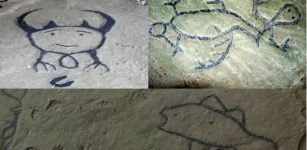Rosetta Stone – Artifact That Solves The Riddle Of Egyptian Hieroglyphics
A. Sutherland - AncientPages.com - A black basalt slab known as the Rosetta Stone was found by a French artillery officer Boussard during Napoleon Bonaparte's Egyptian campaign in 1799.

The artifact thus held the key to solving the riddle of hieroglyphics, a written language that had been "dead" for nearly 2,000 years.
The artifact was discovered among the ruins of Fort Saint Julien, near the town of Rosetta, about 35 miles north of Alexandria, Egypt.
Inscribed with ancient writing, this artifact of great importance came into the possession of the British Government at the capitulation of Alexandria and since 1802 - except for a brief period during World War I - is now preserved in the British Museum.
The Rosetta Stone is only a fragment of much larger stele. However, no additional fragments of the artifact were discovered despite several archaeological attempts. As the Rosetta Stone fragment was found in damaged state, none of the three texts that cover it, is complete.
The irregularly shaped stone contained fragments of passages written in three different scripts: Greek, Egyptian hieroglyphics and Egyptian demotic.
The top register of the Stone (Egyptian hieroglyphs) are seriously damaged. Only the last 14 lines of the hieroglyphic text can be seen; all of them are broken on the right side, and 12 of them on the left. The next register (below) of demotic text (Egyptian script related to the Nile Delta) is composed of 32 lines, of which the first 14 are only slightly damaged on the right side. The last register of Greek text contains 54 lines, of which the first 27 survive in full; the rest are increasingly fragmentary due to a diagonal break at the bottom right of the stone.
The ancient Greek on the Rosetta Stone told archaeologists that it was inscribed by priests honoring the king of Egypt, Ptolemy V, in the second century B.C.
More startlingly, the Greek passage announced that the three scripts were all of the identical meanings.
The artifact thus held the key to solving the riddle of hieroglyphics, a written language that had been "dead" for nearly 2,000 years.
It is believed that Rosetta Stone was originally displayed in a temple, and later moved during the early Christian or medieval period. Finally, it was used as a building material in the construction of Fort Julien near the town of Rashid ("Rosetta") in the Nile Delta.
The artifact is the first Ancient Egyptian bilingual text recovered in modern times. The Rosetta Stone gained widespread public interest and many made attempts to translate it. Lithographic copies and plaster casts reached many European museums and scholars.

Experts inspecting the Rosetta Stone during the International Congress of Orientalists, 1874 Image credit: The Freeman Institute
In the meantime, British troops defeated the French in Egypt in 1801 and the city of Alexandria capitulated the same year. In this situation, the original Rosetta Stone came into British possession and was transported to the British Museum, where it is displayed since 1802.
Several scholars, including Englishman Thomas Young, made progress with the initial hieroglyphics analysis of the Rosetta Stone. French Egyptologist Jean-Francois Champollion (1790-1832), who had taught himself ancient languages, ultimately cracked the code and deciphered the hieroglyphics using his knowledge of Greek as a guide.
Hieroglyphics used pictures to represent objects, sounds, and groups of sounds.
Once the Rosetta Stone inscriptions were translated, the language and culture of ancient Egypt were suddenly open to scientists as never before.
The Rosetta Stone is one of history’s most rare finds.
Written by – A. Sutherland - AncientPages.com Senior Staff Writer
Copyright © AncientPages.com All rights reserved. This material may not be published, broadcast, rewritten or redistributed in whole or part without the express written permission of AncientPages.com
Expand for referencesMore From Ancient Pages
-
 Societies In Iberian Peninsula Deployed “Escape Economics” 4,000-Year-Old
Archaeology | Sep 28, 2022
Societies In Iberian Peninsula Deployed “Escape Economics” 4,000-Year-Old
Archaeology | Sep 28, 2022 -
 Ancient Glass Workshop Unearthed At Iron Age Of Němčice
Archaeology | Jul 24, 2023
Ancient Glass Workshop Unearthed At Iron Age Of Němčice
Archaeology | Jul 24, 2023 -
 13th Century Black Book Of Carmarthen: Erased Poetry And Ghostly Faces Revealed By UV Light
Artifacts | Apr 4, 2015
13th Century Black Book Of Carmarthen: Erased Poetry And Ghostly Faces Revealed By UV Light
Artifacts | Apr 4, 2015 -
 Meat And Fish Market Uncovered In Ancient City Of Aigai, Turkey
Archaeology | Nov 3, 2018
Meat And Fish Market Uncovered In Ancient City Of Aigai, Turkey
Archaeology | Nov 3, 2018 -
 Secret Passageways And Caves Beneath UK’s City Of Nottingham
Featured Stories | Feb 14, 2023
Secret Passageways And Caves Beneath UK’s City Of Nottingham
Featured Stories | Feb 14, 2023 -
 Mystery Of The Watchers And Book Of Enoch – Fallen Angels And Their Secret Knowledge
Biblical Mysteries | Oct 27, 2017
Mystery Of The Watchers And Book Of Enoch – Fallen Angels And Their Secret Knowledge
Biblical Mysteries | Oct 27, 2017 -
 Did A Comet Explosion Over North America Lead To Downfall Of Ancient Hopewell Culture?
Archaeology | Feb 2, 2022
Did A Comet Explosion Over North America Lead To Downfall Of Ancient Hopewell Culture?
Archaeology | Feb 2, 2022 -
 2,550 Submerged Wooden Objects Recovered From The Templo Mayor Of Tenochtitlan
Archaeology | Jun 25, 2022
2,550 Submerged Wooden Objects Recovered From The Templo Mayor Of Tenochtitlan
Archaeology | Jun 25, 2022 -
 Ancient Mystery Of The Leo Petroglyphs In Ohio Created By An Unknown Native American Culture
Featured Stories | Dec 21, 2020
Ancient Mystery Of The Leo Petroglyphs In Ohio Created By An Unknown Native American Culture
Featured Stories | Dec 21, 2020 -
 Mysterious Rock Inscription Found In Brittany Baffles Experts – Reward If You Can Decipher It
Archaeology | May 15, 2019
Mysterious Rock Inscription Found In Brittany Baffles Experts – Reward If You Can Decipher It
Archaeology | May 15, 2019 -
 Amazing Underground Ancient Roman City Discovered In Italy
Archaeology | Jun 12, 2020
Amazing Underground Ancient Roman City Discovered In Italy
Archaeology | Jun 12, 2020 -
 Easter Island’s Statues Reveal Bodies Covered With Unknown Ancient Petroglyphs
Archaeology | Jan 21, 2014
Easter Island’s Statues Reveal Bodies Covered With Unknown Ancient Petroglyphs
Archaeology | Jan 21, 2014 -
 Impressive Gaulcross Hoard Reveals Secrets Of Mysterious Picts
News | Jun 20, 2016
Impressive Gaulcross Hoard Reveals Secrets Of Mysterious Picts
News | Jun 20, 2016 -
 Did Lead Pollution Cause IQ Declines Among Ancient Romans?
Places | Jan 8, 2025
Did Lead Pollution Cause IQ Declines Among Ancient Romans?
Places | Jan 8, 2025 -
 Afterlife: Ancient Egyptian Mummification Balms Studied
Archaeology | Aug 31, 2023
Afterlife: Ancient Egyptian Mummification Balms Studied
Archaeology | Aug 31, 2023 -
 DNA Study Of Controversial Ancient North American Mummies, Including The Spirit Cave Mummy Opens An Extraordinary Chapter In Human History
Archaeology | Nov 15, 2018
DNA Study Of Controversial Ancient North American Mummies, Including The Spirit Cave Mummy Opens An Extraordinary Chapter In Human History
Archaeology | Nov 15, 2018 -
 The Hobbit – An Ancient Hominin Species May Still Be Living In The Forests Of Flores Island – Anthropologist Says
Archaeology | Apr 20, 2022
The Hobbit – An Ancient Hominin Species May Still Be Living In The Forests Of Flores Island – Anthropologist Says
Archaeology | Apr 20, 2022 -
 Ancient Mystery Of Peculiar Nail With Six Faces And Six Eyes – Unusual Discovery In Borgholm Castle, Sweden
Artifacts | Jan 8, 2017
Ancient Mystery Of Peculiar Nail With Six Faces And Six Eyes – Unusual Discovery In Borgholm Castle, Sweden
Artifacts | Jan 8, 2017 -
 Puzzling Ancient Artifacts Found In Canadian Mountains Defy Explanation – Scientists Say
Featured Stories | Aug 27, 2024
Puzzling Ancient Artifacts Found In Canadian Mountains Defy Explanation – Scientists Say
Featured Stories | Aug 27, 2024 -
 Pandavleni Buddhist Caves: Sculptures, Inscriptions And Sophisticated Water Management System
Civilizations | Dec 8, 2016
Pandavleni Buddhist Caves: Sculptures, Inscriptions And Sophisticated Water Management System
Civilizations | Dec 8, 2016

